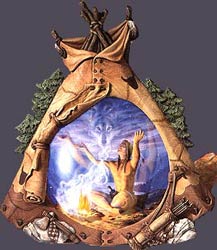Crying for a Vision

For generations, the vision quest has been an extremely important part of Lakota life and ritual. Until recent times, all young men sought this experience, sometimes as young as 10 or 11 and never later than their early teens.
Later in life, men would often return for another vision quest when seeking guidance in the affairs of life. Women would vision quest too, but not as regularly as men. The practice, though not as prevalent, has never been abandoned by the people and is still carried on today.
Besides the young, who vision quest at the beginning of the path to adulthood, a person might choose to cry for a vision in order to better understand another vision they already had, or to prepare for the Sundance, or ask a favor from Wakan Tanka, or as a thank you to Wakan Tanka for gifts received or simply to realize a closeness with the Great Spirit.
When it is time for a vision quest, the seeker brings a pipe to a holy man to ask for help and counsel. If the holy man thinks this is a good idea and agrees to help, a day is set aside. Often times questors were accompanied by a holy man or guide, sometimes they went alone.
On the day of the vision quest, the holy man and assistants go into the sweatlodge with the person making the quest. The object is purification. The one seeking a vision or the holy man would have already selected a place that was rugged and remote that would lend itself to spiritual thought without distraction.
After the sweat, the holy man and assistants prepare a place while the seeker waits. A rectangular place, approximately four- to six-feet wide and six- to eight-feet long, is cleared and a pole with tobacco offerings is put at the center. Other smaller poles are placed at the four directions, with offerings and the representative colors of the four directions tied to each of them. Sage is spread near the center pole as a “bed” for the seeker rest on when tired.
When the place is readied, the other leave and the seeker arrives with pipe, buffalo robe and offering sticks, praying as he approaches. He goes to the center pole and faces west, and then walks to the pole that has been placed in the west. Here he prays again with his pipe in his hands. He then returns to the center pole and goes to the north and repeats the process. Same with the east and the south, taking as much time as needed in any or all directions. When finished with all four, he starts prayer again, all day and into the night. Sometimes he may just stand and face the Sun, other times he may sit and meditate, facing east. During these times the pipe is placed at the west end of the rectangular space as a point of focus.
The seeker may sleep on the bed of sage, with his head at the center pole, but the entire duration of the vision quest he does not eat or drink. Many vision quests last just a day and a night, but others seeking a vision may stay two, three or even four days. Rarely is a quest longer than four days and four nights.
The idea is for the seeker to pray hard from the heart and pay attention to the world around him. If he does, messages from Wakan Tanka will come to him. Sometimes a message or instructions come through nature in the form of an animal or bird. Nothing should be discounted as the Wakan Tanka can, and does, speak through all things. And generally some physical representation of the vision or message (feather, fur, rock) is collected and placed in the seeker’s medicine bag to ensure the power of the vision would stay with the individual to remind, protect or guide him.
When the time is up, the holy man and his assistants come to get the seeker and they all return to the sweatlodge. During the sweat, the seeker tells them of what he saw and heard, being careful not to leave anything out. Sometimes, a vision does not come, and that is reported too. When finished, the holy man prays and gives thanks to Wakan Tanka for all things given and for having pity on the person seeking the vision.
Vision quests are not generally discussed openly, but sometimes the details come out long after, only to amaze and astound the listener of the tale.





